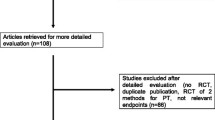Summary.
Percutaneous dilatational tracheostomy (PT) and translaryngeal tracheostomy (TLT) are relatively new minimally invasive methods for critically ill patients. To compare the perioperative procedural safety we analyzed the severity of perioperative blood gas changes in a prospective randomized clinical study in 50 patients (34 men, 16 women; age 18–84 years). Additionally, early complications were documented. Twenty-five PTs and 25 TLTs were performed under tracheoscopic guidance. Perioperative hypoxia did not occur in either group; however, a decrease of PaO2 of more than 50 mm Hg was noticed in nine patients during TLT versus three patients with PT (P = 0.051). The mean increase of PaCO2 was significantly higher in the TLT-group (5.2 ± 6.7 vs 11.6 ± 8.4 mm Hg; P < 0.01). In the PT group no perioperative complications arose; in the TLT group one procedure was not successful and had to be converted to a PT. Postoperatively, one premature decannulation (PT group) and one bleeding (TLT group) were noticed. PT and TLT are safe methods. Early complications are rare in experienced hands. TLT tends to cause relevant hypercarbia and should therefore be restricted to patients without special risks.
Zusammenfassung.
Die Punktionstracheostomie (PT) und die translaryngeale Tracheostomie (TLT) sind relativ neuartige, minimal-invasive Methoden zur Behandlung von langzeitbeatmeten Intensivpatienten. Beide Verfahren werden erstmals innerhalb einer prospektiv-randomisierten Studie an 50 Intensivpatienten (34 m., 16 w., Alter: 18–84 Jahre) hinsichtlich ihrer Frühkomplikationsrate und der perioperativen methodenbedingten Beeinträchtigung der Beatmung verglichen. Bei je 25 Patienten wurde eine PT bzw. eine TLT durchgeführt. Perioperativ wurde in beiden Gruppen keine Hypoxie beobachtet, allerdings war ein Abfall des PaO2 um mehr als 50 mm Hg während der TLT 9mal, bei der PT nur 3mal festzustellen (p = 0,051). Außerdem war der mittlere Anstieg des PaCO2 in der TLT-Gruppe signifikant höher (5,2 ± 6,7 vs. 11,6 ± 8,4 mm Hg; p < 0,01). In der PT-Gruppe kam perioperativ keine Komplikation vor, nach TLT mußte einmal zur PT konvertiert werden, nachdem die Kanülenspitze disloziert war. Postoperativ trat einmal eine vorzeitige akzidentelle Dekanülierung nach PT und eine Blutung nach TLT auf. PT und TLT sind bei entsprechender klinischer Erfahrung sichere Methoden. Da bei der TLT unter Umständen mit einer erheblichen Hyperkapnie und einem Abfall des arteriellen Sauerstoffpartialdruckes zu rechnen ist, sollte dieses Verfahren nur bei Patienten ohne spezielle Risiken angewandt werden.
Similar content being viewed by others
Author information
Authors and Affiliations
Rights and permissions
About this article
Cite this article
Walz, M., Peitgen, K. Punktionstracheostomie versus translaryngeale Tracheostomie Eine prospektiv-randomisierte Studie bei 50 Intensivpatienten. Chirurg 69, 418–422 (1998). https://doi.org/10.1007/s001040050432
Issue Date:
DOI: https://doi.org/10.1007/s001040050432




